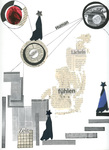 |
| Angelika/Mike Schilli |
Angelika The Christmas tree has been bought and is waiting on the balcony for its big appearance on December 24th. The last workday is done, and now I have 2 weeks of Christmas vacation: it's time for the Christmas newsletter.
Christmas traditionally represents a time of giving, which is also evident in the increased number of letters we receive around this time of year asking for end-of-year donations. In the USA, many organizations cannot survive without donations because the government often plays a minor role in funding social and cultural projects. For my Christmas newsletter, I would like to introduce you to two increasingly popular trends that are not necessarily limited to the USA but are still considered quintessentially American: the rise of private museums built to showcase the art collections of private individuals to the public, and the so-called "Service Learning," which is also being attempted in a limited way at the school where I work.
First, let's talk about museums. Over Thanksgiving, we both had a week off and spent it in Los Angeles, specifically in Venice Beach. Since we always try to discover something new, this time we visited the private museum The Broad in Downtown Los Angeles. The museum cost 140 million dollars to build, for the specific purpose of of showcasing the private art collection of Eli and Edythe Broad. It opened in the fall of 2015 and displays modern artworks that the couple has acquired over decades, as well as various additional exhibitions.
The building is architecturally interesting, modern, and imposing. Eli Broad searched for a long time for a suitable place in Los Angeles to display his collection and then decided to erect a new building in Downtown. Downtown L.A. is experiencing something of a renaissance, partly due to institutions like "The Broad," after the city center had long languished with many vacant buildings. Eli Broad became a multi-billionaire by initially making a fortune in Detroit through building and selling houses. However, that was not enough for him, and he then moved into the insurance industry, where he was very successful a second time with his company Sun America. His wife Edythe has been and still is the driving force behind acquiring art. The couple (both now well over 80 years old) is now fully dedicated to philanthropy. They are part of the group of billionaires (The Giving Pledge) who have committed to donating at least half of their wealth. Melinda and Bill Gates, Warren Buffet, Mark Zuckerberg, and his wife are also part of this group.
But back to the Broad Museum. The museum owns 2,000 artworks, including pieces by Joseph Beuys, Andy Warhol, Jeff Koons, Yayoi Kusama, and Roy Lichtenstein. Admission is free, but visitors must pay for special exhibitions. You can pre-order tickets for a specific time of day online, so you don't have to line up with spontaneous visitors. Otherwise, the wait time can be up to 2 hours.
The museum is very popular. As mentioned, "The Broad" is just one of many museums in the USA that is not only privately owned but also exclusively showcases a private collection. In general, I find it commendable when artworks do not disappear into private villas but can be enjoyed by a broad public. However, there are also critical voices that argue that private collections often display a hodgepodge of works that reflect the owner's taste but do not necessarily follow curatorial or art historical criteria. In any case, we were thrilled to examine original works that we had previously only known as reproductions.
In the USA, it is relatively common for students to engage in volunteer work. This often has pragmatic reasons, as good grades alone are not always enough to get into a good college; personal social engagement also counts. Many schools have now adopted the concept of "Service Learning" (roughly translated as "learning through social engagement"). The idea is to provide students with experiences through social engagement to strengthen their social skills. Ideally, students get involved in their own neighborhood or the school's neighborhood. This could involve, for example, helping out in the clothing room of a charitable organization, cleaning up the local playground, or familiarizing seniors in a retirement home with new technologies.
In Service Learning, students are not simply sent off on their own; they are prepared for it in class. Goals are set, and the experiences and lessons learned are reflected upon. The new vice-principal at my school is an enthusiastic supporter of this educational method. However, since our students are still relatively young, it is often not easy to find suitable projects, as many require a minimum age for students to volunteer. So, we are starting small at our school. Before the Christmas holidays, we collected winter jackets because one of our staff members volunteers with the homeless. The idea was for the children to either donate a jacket in good condition from home or buy one from a second-hand store with their saved-up pocket money. In class, we talked several times with the children about the how, why, and wherefore. As mentioned, this is still in its early stages for us, but a start has been made.
In this spirit, we wish you all a Merry Christmas and a satisfying year 2020.
Angelika and Michael






